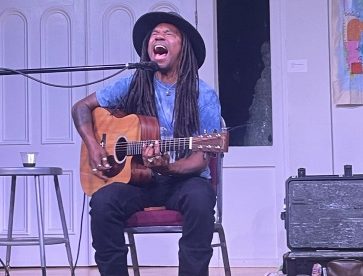
Julian Taylor, a Canadian award-winning singer and songwriter, performed in front of the Clinton community on Saturday Sept. 20. The event brought together Hamilton alumni, faculty and members of the larger Clinton community. After finishing each rendition, Julian Taylor took time to exchange with the crowd. He reflected on what his songs mean to him and how his past has shaped who he is. While deeply personal, his songs involve themes and life experiences to which we can all relate.
Prior to the concert, Kirkland Arts Center Board President Ernest Williams took a few minutes to discuss many of the ways in which KAC is involved within the local community. He mentioned the Kirkland Trails, whose three miles of rails-to-trails includes paths for walking, running, biking and bird watching. In early May and June, the trails become a homeground for migratory birds who come from the neotropics, while blooming flowers announce spring’s arrival. The trails were built atop what once was the Kirkland Railroad, which paralleled the Chenango Canal and was critical for transporting goods throughout upstate New York decades ago. If the outdoors aren’t your thing, Williams made sure to provide alternatives to get involved. “From yoga, to line dancing, to up-and-coming cooking classes,” he said. “We are an important part of this community and want you to also be a part of it.”
While Taylor’s concert was held in the Kirkland Arts Center’s main exhibit room, it featured work from Ramiro Davarro-Comas, an Argentinian artist known for his large-scale paintings depicting cultural transitions. Anita Welch, the Kirkland Arts Center’s Executive Director, described the paintings as “speaking to [Davarro-Comas’] experience as a young child coming to a new land, where everything was new and looked different.” She continued by saying that “immigrant families adapt and embrace the challenges and customs of their new country,” and that while Davarro-Comas “felt different since childhood and had trouble relating, he would wear a ‘mask’ to fit in.” His works tackle the notions of identity, belonging, and change. Although he varies the creative mediums used, from spray painting, to drawing, stitching and other forms of mixed media, Davarro-Comas retains a willingness to create work that represents the people he identifies with. Within the KAC, certain of his works were especially eye-catching, such as “Una manzana por dia” and “Father BBQ”, both part of his “Familias” collection. In all of his paintings, vulnerability, shame and cultural isolation are hidden far behind the white mask every character wears. In collaboration with the Clinton Middle School, Davarro-Comas hosted multiple workshops with students, where they were able to unleash creativity through paintings that reflected their own identities. The students’ works are framed next to the Argentinian artist’s paintings in the main exhibition room. If you are interested in further exploring Davarro-Comas’ work, the exposition at the Kirkland Arts Center will be available for viewing until Oct. 11, 2025.
At 8 p.m., Taylor came on stage to begin his performance. He sang a total of 11 songs, split into two sets separated by a short break. Taylor began with “The Ridge”, the opening song of his album by the same title. He then continued with “Wide Awake”, a song which invoked feelings of hopelessness and transitioning through life: “Right now I’m trying to live in the present, but chased by shadows of my past.” Before the next song, Taylor spoke about the inspiration for his album “Beyond the Reservoir”, released in 2022. “Walking around my house and seeing my family, I felt lucky and grateful for the life I had, Taylor said. “But sometimes, I forget to slow down and be grateful for what I have.” His next song, “Be With You,” addressed similar regrets with life moving forward: “Nothing seems to be going alright, but that’s fine with me. All I want to do is be with you.”
Following that, Taylor spoke about his personal background. As a Black and Indigenous artist, Taylor appreciates the way indigenous culture measures time “not as past, present and future, but as a circle that is always connected.” His song “Back at You” aligns with this idea, with lyrics such as “like mountains, we turn to sand. We will come back again.” After a short intermission where Taylor sold shirts, CDs and signed autographs, the second part featured songs such as “Bobbi Champagne”, a song about a short-lived relationship; “Pathways”, which discusses finding unity within your community; and “Ain’t Life Strange”, which tackles nostalgia. Ultimately, Taylor concluded his concert at the KAC over a crowd of applause.
Williams reflected on the reception of the award-winning singer-songwriter, saying, “Julian Taylor is a fine folk musician, and his concert was excellent and well-received. The audience was smaller than we had hoped, however, so although it was wonderful musically, it was less successful financially.” Looking forward, he hopes more Hamilton students can make their way down the hill and attend events at the KAC: “The KAC provides a lot of activities for our local community, and the KAC itself is central to the village being right across from the village green. A number of Hamilton faculty and staff, both retired and currently employed, are very involved in KAC activities. Come check out what the KAC has to offer!”